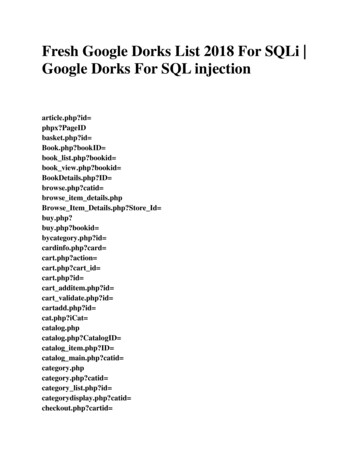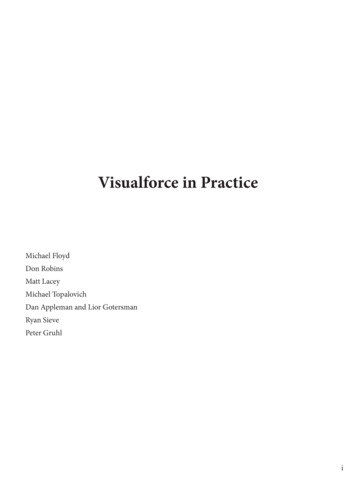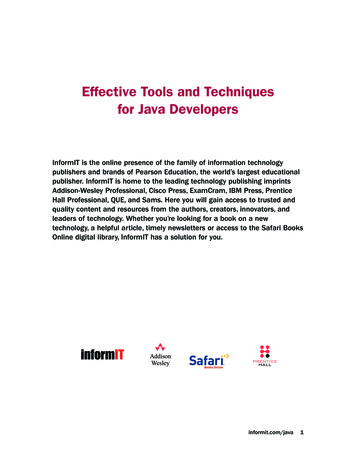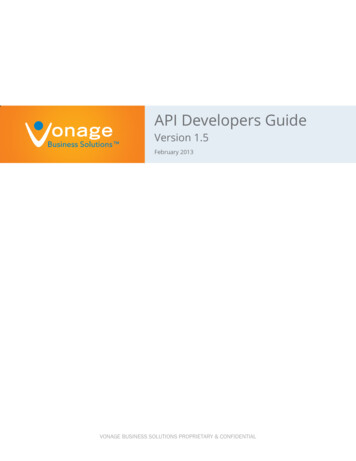
Transcription
WhitepaperMoving to HTML5 Video
Executive SummaryWeb and mobile video is growing rapidly, with watch time increasing by 60%year-on-year. As demand increases, the underlying technology is also developingrapidly. For many top media sites, HTML5 video has now replaced Flash as thepreferred platform for web and mobile delivery.HTML5 video is a proven technology with billions of hours of content deliveredmonthly and a large and thriving ecosystem. Recent HTML5 video technologyadvances make it a fully-featured platform, allowing full custom player control,digital rights management (DRM), and adaptive bitrate streaming support forboth on-demand and live video.Major MediaSites are Movingto HTML5YouTube, Netflix, Amazon,Facebook, BBC, New YorkTimes and other major mediaproperties today deliver videowith HTML5.As users move to the mobile web, the use of Flash Player is decreasing.Content publishers are strongly encouraged to transition to HTML5 videoto broaden their reach and improve user experience.Moving to HTML5 Video: Key StepsVideo Player: Select and customizeWeb Page: Translate from Flash to HTML5Ads Platform: Convert to HTML5Media: Transform to HTML5-friendly formatsDRM: Encrypt premium content, select technologiesHTML5 offers clear advantages, but executing an HTML5 transition can takeseveral months. Content publishers should analyze their needs and makea future-proof plan quickly. The sooner a publisher transitions, the soonerthey can realize the cost savings, longer watch times and improved userexperience of HTML5 video.HTML5 video hasseveral advantagesover Flash:Less ComplexityCreate a single player solutionand experience for desktop andmobile webHappier ViewersA better user experience withfaster page loads and shorterstart timesMore PowerReduced battery consumptionon laptops with native playbacksupportLower CostsWhen using advanced codecs,lower distribution andstorage costs
2007FactsHTML5 video. is supported by billions of mobile, desktop and connected devices allows content protection (DRM) and adaptive streaming delivers a superior user experience to Flash streams billions of hours of media every monthHistoryPre-2007 Web video playback required browser plugins Users must download plugin to watch video Publishers must support multiple plugin versions2007 HTML5 video tag introduced Audio and video become first-class web citizens Native video implementations in browsers No features for DRM, adaptive streaming Limited device and format supportToday2016 Flash use is declining, and not supported on mobile Users are migrating to mobile Mobile watch times are increasing by 100% per year Broad device support with billions of end points DRM and adaptive streaming technology available HTML5 video is a viable platform for premium content Major sites (Amazon, Facebook, Netflix, YouTube) switch toHTML5 video
Key TechnologiesHTML5 video is enabled through browser support for video and audio playback, Javascript extensions to control thatplayback, and ecosystem support for critical functions such as content protection and advertising. This section providesmore detail on key HTML5 technologies.Key Technology: Player ControlKey Technology: Content ProtectionThe addition of Media Source Extensions (MSE)gives HTML5 video developers control over howmedia data is delivered to the browser usingJavascript. MSE allows your web site to offer smoothplayback, adapting to changes in a viewer’s availablebandwidth by streaming different bit rates. Thistechnique is called adaptive bitrate streaming andis enabled by media formats such as MPEG-DASH.The addition of Encrypted Media Extensions (EME) to HTML5video provides digital rights management (DRM) capabilities.This is particularly important for premium content publishers whorequire that their video be protected. Three key considerationswhen planning an HTML5 transition include content encryption,DRM system support, and user authentication.MSE is widely supported by mobile and desktopbrowsers, and adaptive bitrate streaming via MSEis enabled by a variety of player technologies.HTML5 also offers full-screen viewing, customizedplayer experiences, and timed text (caption) display,giving a complete video experience.Takeaway:HTML5 gives you a fully customizableviewer experience, with support for adaptivebitrate formats.Content Encryption: EME allows reuse of encrypted assetsacross many HTML5 platforms. Specifically, HTML5 videocan be encrypted once using the ISO BMFF/CENC format andstreamed to many browser, mobile, and CE platforms, savingcritical asset storage and maintenance costs.DRM System Support: Browsers and devices supporting EMEgenerally each only support one DRM system. Microsoft Edgeand Internet Explorer support Playready; Safari on OS X supportsFairplay; Chrome, Opera and Android WebView supportWidevine; Firefox supports Adobe Access. While EME doesallow common media encoding and encryption across manyof those platforms, publishers will need to support multipleDRM systems to reach these platforms, or work with a serviceprovider that can manage multiple DRM systems for them.User Authentication: For publishers using authenticationproducts such as Adobe Primetime, they will still be able toauthenticate access with a single toolkit, while supportingDRM for each browser platform.Takeaway:HTML5 allows full digital rights managementacross most major browsers; publishers willneed to support multiple DRM systems toensure full HTML5 DRM support.
Key Technology: Next-Generation Video CompressionKey Technology: Video AdvertisingHTML5 video supports next-generation videocompression, reducing operating costs and improvingviewer experience. When using the VP9 codec, videobit rates can be reduced as much as 45% comparedto H.264. This in turn can help reduce transmissioncosts, and improve video quality. User experience isalso improved by VP9, allowing video playback to start15–80% faster as well as enabling users with lowerbandwidth to watch higher quality video.HTML5 video is starting to replace Flash within advertising.HTML5 supports VPAID 2.0 (a common interface betweenplayers and ad units), which allows interactive video adswithout the use of Flash. Most players and ad platforms nowsupport VPAID 2.0 creatives, making HTML5 fully capableof serving video ads. Leading ad creation, reporting andverification tools have also added support for HTML5, andHTML5 offers a single platform that can work on mobile anddesktop browsers.While most browsers support H.264 decoding today,the newer VP9 codec also has broad support includingChrome, Firefox, Opera, and (coming soon) Microsoft Edge.All told, VP9 can be decoded by over two billion end points.This is good news for users. HTML5 does not load a plugin,and advanced codecs can also result in faster playback.HTML5 start times can be 15–80 percent faster than Flash.For ad-supported content this reduces viewer wait timesand increases engagement.Content providers don’t have to pick a single compressionformat, because simple HTML5 calls can detect what codecsare supported in each session. This allows providers toprepare multiple compression formats, allowing the playerto pick the best one for each user, resulting in an improvedexperience. Content providers who wish to reduce costs andimprove viewer experience should consider adding VP9video compression as an available format.Takeaway:HTML5 enables use of next-generationvideo compression, improving viewerexperience and lowering costs.This is also good news for ad creatives. HTML5 ads havemore reach because they can be displayed in both mobileand desktop browsers — meaning one ad unit can runacross multiple devices. Creating HTML5-based video adsrequires creatives to change their process for submission, butthe tools for creating HTML5 ads are available and many areactually the same tools creatives are already using for Flash.For publishers, this means that the ad ecosystem is movingto HTML5 video. Major media properties such as YouTuberequire videos compatible with HTML5. As creatives movetowards HTML5-based ads, publishers should have a planfor their HTML5 video migration to avoid disruptingad-supported revenue.Takeaway:Video advertising tools, players, andplatforms are ready. With support for mobile,HTML5 ads have greater reach than Flash.As ad platforms stop accepting Flash,creatives will move to HTML5.
Device andBrowser SupportAll major browsers now support HTML5 video, and many support next-generation video compression as well.The following table lists key browsers and their support for HTML5 features:MSEBrowserEMEVP9Browser SupportBrowser VersionContainerSupportedBrowser VersionDRMSupportedFirefox (Desktop)42 mp4, WebM38 (Windows)Adobe28 Chrome (Desktop)23 mp4, WebM42 Widevine29 Microsoft IE(Desktop)11 mp4PlayReady-All versionsmp4, m2tsAll versionsPlayReady(mp4 only)In DevelopmentOS X Yosemitemp4, m2tsOS X YosemiteFairPlay(m2ts only)-Opera (Desktop)30 WebM32 Widevine15 Firefox (Android)41 mp4, WebM--28 Chrome (Android)30 mp4, WebM42 Widevine29 -----MicrosoftWindows Mobile10 mp410 PlayReady(mp4 only)-Opera (Mobile)30 WebM---Microsoft Edge(Desktop)Safari (Mac)Safari (iOS)11 (Windows 8.1 )
Comparing HTML5 Video and Flash VideoKey Feature ComparisonFeatureHTML5 VideoFlash VideoCustomizable PlayerYesYesPlatformNative support in browserPluginDRM decryptionYesYesAdaptive BitrateStreamingYesYesAd InsertionYesYesPlugin load timeN/A (0 m/s)500ms—2000msGPU accelerated decodeYesYesFull Screen ViewingYesYesAd Protocol SupportVPAID 2VPAID 1 and 2Technology ComparisonFeatureHTML5 TechnologyFlash TechnologySupported CodecsH.264 (most browsers)VP8/VP9 (Firefox, Chrome, Edge, Opera, Android)VP6, H.264DRM SupportWidevine, Playready, Fairplay PrimeTime(depends upon browser)Supported Containersmp4, WebM, m2ts(depends on browser)Adaptive Bitrate SupportMPEG-DASHPrimeTime(formerly Access)mp4, flvHLS, HDS
Planning your TransitionMigrating to HTML5 video has several considerations. It’s important to plan early and give your organization time to makethe transition smoothly.Web Page User InterfaceVideo AdvertisingIf you’re using Flash for your video player, you may beusing Flash for other user interface elements as well.Bookmarks, title metadata, chapter markers, even yourcompany logo may be using Flash. Your creative teamshould already have HTML5 support for mobile platforms,but for the desktop they may use Flash in more waysthan you expect.As you review video advertising, it is wise to talk with yourad clients and partners to plan the transition together.Advertisers will need to provide you with HTML5-friendlycreatives that will work on your system, and you may wishto convert existing Flash FLV creatives to MP4. The goodnews is that you can offer broader reach for those creativesacross both desktop and mobile web, but early end-to-endtesting is recommended to ensure a smooth transition.Flash use is declining as users migrate to mobileweb. Browsers are also changing the way that usersinteract with Flash — for example, requiring usersto click on Flash applications before they play. It’simportant to audit the HTML5 experience early, andplan to make it the primary experience.Takeaway:Audit your use of Flash outside of the videoplayer, and make a plan to transition to HTML5as the preferred platform for your user interface.It is also recommended that you talk with your webdevelopers early about advertising. The IAB recommendsthe use of “Friendly iframes” to ensure compatibility withthe rest of your site. Iframes are containers for HTML5content within a page, and they give you control over whatthe content can and cannot do. For example, an iframe maycontrol whether or not an ad can trigger pop-ups. This levelof control is a critical conversation to have early with yourweb developers to ensure that your advertising requirementswill be compatible with the other technology in your site,and with your overall security policies. You will also want toenable HTML5 VPAID 2 within your advertising platform.Takeaway:Talk with your ad clients and partnersearly, and plan end-to-end HTML5 creativetesting. Talk with your web developers earlyto scope the impact of friendly iframes.
Key Decision: Adaptive Streaming?Adaptive Streaming offers multiple quality levels and bit rates to the user by having the player choose which qualitylevel and bit rate to play based upon the user’s bandwidth and other factors. This generally results in a significantlybetter user experience with less buffering, leading to longer watch times.If you choose to support adaptive streaming, your media will need to be processed for that purpose and your playerwill need to support it. The good news is that you may be processing your media anyway as you transition to HTML5video, so this is the perfect time to improve the user experience.Video PlayerMany video player libraries and partner companies support HTML5. Which approach you take may depend upon a variety of factors.Key Questions1. Does your content require encryption and digital rights management?2. Do you rely upon advertising? What type of ads do you need to support3. Does your player have custom controls or displays such as title metadata?4. Do you want to outsource development or do it yourself?5. Do you use a single bit rate, or adaptive streaming?Your approach to an HTML5 player will depend upon the answers tothese questions. The level of customization that is required, and whoyou’d prefer to do the implementation, will affect your approach. Forexample, if you require significant customization and wish to writeyour own code, then player libraries such as Shaka Player allow youcomplete control over the user experience. In contrast, if you preferan out-of-the-box solution, or would like a solution provider to docustomization, there are several player companies that can help you.Identifying your player requirements and approach early isimportant, because it may affect your transition schedule.For example, if you require significant customization, youwill need to plan for the engineering work necessary tospecify and implement the necessary changes.Takeaway:Review your needs, and choose a player. Because you will be processing your media anyway, thismay be an ideal time to migrate to an adaptive bit rate format.
Media ConversionYour media may need conversion in order to work with HTML5. Media file formats and even some codecs supported in Flashmay not be supported in HTML5. For example, VP6 video will need to be replaced with H.264 and possibly VP9, and FLV filesshould be converted to fragmented MP4 containers.Video File Format and Compression: Key Questions Will you be using adaptive bitrate streaming? What clients (devices) do you want to support? Is your media already encoded in H.264 that can be reused (repackaged)? Do you want to use VP9 to improve the viewer experience? Will you support multiple audio language tracks? How will the user select each one? Does your media have timed text or captions?Wherever possible, the creation of your HTML5 contentstreams should be done from the original high-resolution,high-bitrate media, rather than simply converting yourFlash assets. This will give you the highest possiblequality and will also allow you more opportunity toimprove your user experience.Planning should also be done with your content deliverynetwork (CDN) or service provider. Many such vendorsoffer media conversion services and may also havespecific format requirements. Media conversion servicescan save on the infrastructure costs and labor involvedwith converting media yourself.If you are converting the assets yourself, and if you onlyhave a few hundred assets, you may wish to convertthem using desktop software. Alternatively, if yourmedia is hosted in the cloud, you may wish to use cloudservices. Such an approach is particularly appropriatefor non-encrypted media.If you are converting a large, locally-stored library, or ifyou are encrypting your media, you might consider anenterprise-class encoder running on one or more servers.Such encoders can connect with key managementsystems (for DRM encryption) and can create multiplebitrate source files simultaneously (for adaptivestreaming). It is also recommended to use differentkeys for each individual audio and video stream.Finally, make sure to think through the user experience,particularly with audio and captions. If you have multipleaudio tracks (for example, for different languages)then you may want the user to choose a track from theplayer user interface. In this case, you will need to matchyour player technology with your encoded video — forexample, using separate streams for video and audioto save storage. Similarly, if you have timed text orcaptioning, the conversion of that data must be plannedand tested early to ensure a smooth transition. Withmedia formats the details matter and conversion cantake time, so it’s best to test the details early, before thebulk of the conversions occur.Takeaway:Think through your media format(s) early, plan for early testing within the player, and allocatetime and money for media processing.
Key Decision: VP9?VP9 offers significant compression efficiency compared to H.264, and VP9 playback has demonstrably better videoquality and user experience. This translates to broader reach in markets with low bandwidth, and lower transmissioncosts (VP9 can cut bandwidth requirements by as much as 50%). However, there are two key considerations with VP9.First, while over two billion endpoints support VP9 playback, some browsers (e.g. Safari) do not. This meansthat VP9 cannot be used as a single format choice, and you will also require another format such as H.264. Asa result, your storage and asset management costs may increase as you manage both VP9 and H.264 assets.The good news with VP9 is that it can lower CDN costs (by cutting bandwidth as much as 50%) and will improveviewer experience with faster playback start times.Second, while most HTML5 browsers support VP9, some encoding solutions do not. You should review yourexisting encoding solutions to ensure VP9 support. Again, the benefits may outweigh the costs, and thisanalysis should be done early to make an informed decision.Digital Rights ManagementIf you need to protect your media, then youwill need to encrypt it and use a digital rightsmanagement (DRM) system to control access.With HTML5, each browser and device requires adifferent DRM system: FairPlay, Access, PlayReadyor Widevine. While most systems (e.g. Widevineand PlayReady) can use the same encryptedmedia streams, you will still require different keyexchange systems and the maintenance of thosesystems needed to cover your target clients.If you’ve been using Flash, you may already bemaintaining multiple systems — for example, Access(for Flash) and Fairplay (for Apple devices). The goodnews is that while HTML5 may require you to maintainmore DRM systems, it may also reduce your digitalrights management licensing costs; some supportedsystems, such as Widevine, do not charge licensing orother fees. However, your HTML5 transition plan shouldinclude integration with business systems and properkey exchange during the media conversion process. Inparticular, you will likely want to separate your key storeand business logic from individual DRM systems andonly use the DRM servers to verify client requests andissue the actual licenses.It is also recommended to use HTTPS delivery formedia, to ensure user privacy and further protect yourmedia. Talk with your web development team earlyabout adding HTTPS support.Takeaway:HTML5 digital rights management mayrequire you to manage more systems, butit also may reduce your licensing costs.Plan early to ensure that media processingand business systems are integrated withyour DRM systems, and to ensure that yousupport HTTPS delivery.
ConclusionHTML5 offers new and exciting opportunities for web and mobile video. As users move to the mobile web, and as the useof Flash declines, publishers should migrate to HTML5 video.HTML5 Video Migration: Key Considerations Video player selection and customization Web page translation from Flash to HTML5 Ad platform conversion to HTML5 Media transformation to HTML5-friendly formats Digital rights management systems and content encryptionMigrating from Flash to HTML5 can take several months, and publishers are urged to start planning their transitiontoday. The improvement in user experience, watch times, and potential for lower operating costs make HTML5 a winningapproach to web and mobile video.Technical ResourcesThe following links offer you more detail about key HTML5 technologies:Shaka Player is an open source player that demonstrates the use of Encrypted Media Extensions, Media SourceExtensions, and MPEG-DASH parsing. Shaka also offers several example MPEG-DASH manifests for developers,and an online example player to play them back.VP9 is an open-source, royalty-free video codec maintained by the WebM project, whose site offers encoding guides.The EDASH packager allows developers to encrypt media into a fragmented ISO BMFF format with commonencryption (CENC) support.
the tools for creating HTML5 ads are available and many are actually the same tools creatives are already using for Flash. For publishers, this means that the ad ecosystem is moving to HTML5 video. Major media properties such as YouTube require videos compatible with HTML5. As creatives move towards











